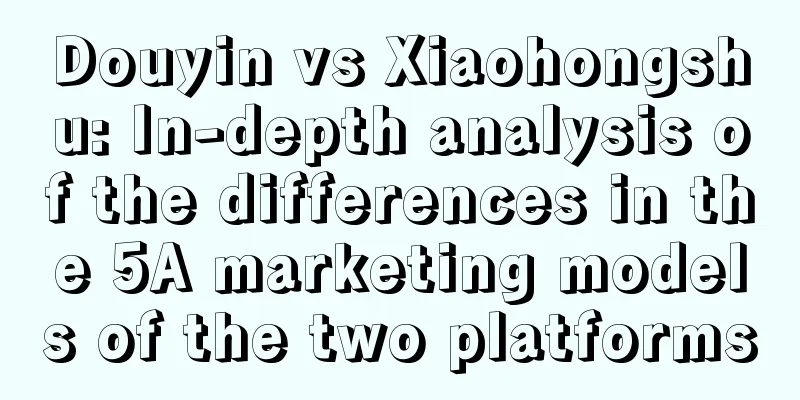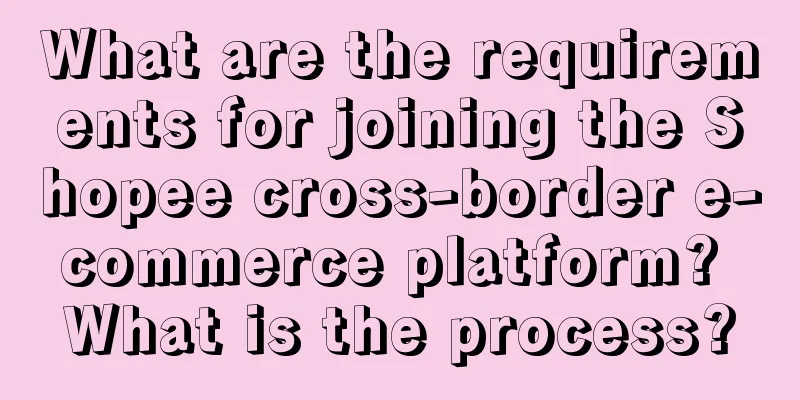Douyin vs Xiaohongshu: In-depth analysis of the differences in the 5A marketing models of the two platforms

Since Philip Kotler proposed the 5A model in Marketing Revolution, this theory has not only profoundly influenced the traditional marketing field, but also become a universal rule in Internet marketing. With the rapid development of digital marketing, the 5A model has been adopted and promoted by more and more online platforms due to its systematicness and efficiency. Many brands even make variations or extensions based on the 5A model to create new models that are more suitable for their own market strategies. For example, Alibaba constructed a similar marketing theory in the early years. In the past two years, with the rise of grass-roots marketing and content e-commerce, the two major content platforms, Douyin and Xiaohongshu, have also launched new marketing theories based on the 5A model. At the end of 2022, Douyin launched the "ByteDance O-5A Crowd Asset Management Methodology", and Xiaohongshu released the "Xiaohongshu Grass Planting Methodology" at the end of 2023. Both use the 5A model as the basis of their strategy, aiming to achieve deeper interaction and connection between brands and users through refined user operations and content innovation. So why is the 5A model favored by so many large platforms? What are the differences between the 5A marketing models of Douyin and Xiaohongshu? This article will explore and analyze these issues. 1. Origin of the 5A ModelThe 5A model, as the core framework of modern marketing strategy, is generally attributed to the innovation of Philip Kotler, but its essence is the crystallization of the collective wisdom of the marketing community. Just as Marxist theory draws on the essence of classical economics and Hegelian philosophy, the 5A model is also a synthesis that has gradually formed on the basis of numerous marketing theories. In 1898, when the concept of advertising marketing was still in its infancy, E. St. Elmo Lewis proposed the AIDMA theory. This theoretical framework systematically explains for the first time the psychological process of consumers from contact to action, namely Attention, Interest, Desire, Memory, and Action. The value of the AIDMA model is that it provides a clear logical framework for traditional marketing advertising, allowing advertising to be evaluated and optimized according to this process. For example, Coca-Cola successfully embedded its brand in people's hearts through repeated brand exposure and emphasis on product characteristics under this framework. In 2005, with the popularization of the Internet, AISAS theory came into being. This theory was proposed by Dentsu of Japan, which replaces the "memory" stage in the original AIDMA model with "Search", namely Attention, Interest, Search, Action, and Share. The AISAS model reflects the new behavior pattern of consumers in the golden age of Internet search, that is, after consumers become interested in a product, they will use search engines to obtain more information and make more informed purchasing decisions. SEO marketing is a marketing method that came into being under this framework. Many brands improve their brand visibility and influence by optimizing search engine rankings. At the beginning of the 21st century, with the rapid development of social media and mobile Internet, Philip Kotler further developed the 5A model, integrating and innovating the traditional AIDMA and AISAS models to form the current Awareness, Appeal, Ask, Act and Advocate. This model emphasizes the management of the entire process from awareness to advocacy, which is particularly suitable for the social media era, where brands must not only attract consumers but also motivate them to become active promoters of the brand. The value of the 5A model lies in its inheritance and innovation of the AISAS model. Although the two are not fundamentally different in their paths, the 5A model improves the model's memorability and communication by changing all key words to start with A, making it easier for marketers and brands to accept and use. The value of the 5A model lies in its comprehensive and systematic perspective, which can adapt to the ever-changing market and technological environment. In the era of social media, brands can use the 5A model to build interactive relationships with consumers, which not only allows consumers to recognize and generate purchasing behavior, but also inspires them to become loyal supporters and active communicators of the brand. For example, through social media marketing activities, brands can stimulate consumers' enthusiasm for participation and, through UGC (user-generated content) and other forms, allow consumers to become spontaneous disseminators of the brand, thereby spreading and enhancing the brand's influence. 2. What is the difference between Douyin and Xiaohongshu 5A?From 2022 to 2023, Douyin and Xiaohongshu respectively proposed a 5A model based on their own platforms. Tik Tok's model is O-5A, where O stands for opportunity groups or potential consumers, and 5A stands for A1 (understanding), A2 (attraction), A3 (planting grass), A4 (purchase), and A5 (repeat purchase). The difference here from Kotler's 5A is that A3 inquiry becomes planting grass, and A5 advocacy becomes repeat purchase. Xiaohongshu's 5A model is A1 (acquaintance), A2 (planting grass), A3 (deep planting grass), A4 (purchase), and A5 (sharing). The difference here from Kotler's 5A is that A2 attraction becomes planting grass, and A3 inquiry becomes deep planting grass. What is the difference between Douyin and Xiaohongshu 5A? Let me briefly analyze the path: A1 is about information reach, there is no difference between the two platforms. A2 Xiaohongshu defines "planting grass" as generating interest and short-term memory. There is no special action here, it just means initial interest after seeing a message. Douyin defines "attracting" and the action is clearer, which is visiting the homepage or liking, commenting, etc. This is the biggest difference between the two. A3 of Douyin’s grass-roots promotion refers to search, add to cart, and jump, while Xiaohongshu’s in-depth grass-roots promotion refers to active search, in-depth reading, collection, forwarding, screenshot saving, and commenting. Here, Xiaohongshu puts both A2 and A3 of Douyin in A3. It’s the same for all A4 purchases, no further explanation. A5 Douyin is about repurchase and pays more attention to the effect, while Xiaohongshu is about sharing and pays more attention to the exposure and influence brought by sharing. 3. What are the differences in the marketing focus between Douyin and Xiaohongshu?The above discusses the differences between the two in their marketing paths, but because of the differences in the characteristics of their platforms and their target audiences, there are also differences in all dimensions of marketing based on 5A. 1. Content dimension:The TikTok platform mainly uses short videos, emphasizing quick browsing and high-frequency interactions, and the conversion from A1 (understanding) to A4 (action) stages is very rapid. This fast-paced consumption model is very suitable for rapid dissemination and instantaneous attraction of a large number of users' attention. In particular, through algorithm recommendations, some highly infectious live broadcast content can quickly attract user groups and achieve instant sales in the live broadcast room. For example, a promotional live broadcast of a popular product can trigger a large number of orders in a short period of time. Compared to Douyin, Xiaohongshu encourages the generation of in-depth content, such as detailed product reviews and usage experiences. This content strategy supports users to conduct in-depth reading and detailed discussions, thereby deepening user engagement and interest in the A2 (grass planting) and A3 (deep grass planting) stages. For example, after seeing a detailed product review, users will be motivated to search for more relevant information, which not only deepens their understanding of the product but also increases the likelihood of purchase. 2. Interactive dimension:Douyin’s design emphasizes instant feedback and promotes user engagement through quick interactions such as likes, comments, and shares. This instant interaction greatly enhances the user experience from A2 (attraction) to A3 (planting grass) stages. For example, after a user likes or comments on a short video, the system will quickly recommend related products, prompting the user to further explore and purchase, accelerating the conversion from interest to action. Xiaohongshu focuses on building a community environment based on trust and common interests, which is conducive to the development of the A5 sharing stage. Users' interactions on Xiaohongshu tend to be more in-depth exchanges, such as writing detailed feedback and recommendations after using a product. These contents are often widely disseminated by other users, helping to form a strong word-of-mouth effect. Users become loyal advocates of brands by sharing their real experiences. 3. Reach dimension:TikTok uses its efficient algorithm recommendation system to quickly push excellent content to a large number of users, thereby achieving rapid user reach and wide market coverage. This strategy is particularly useful for quickly increasing user attention during the A1 (awareness) and A2 (attraction) stages. In contrast, Xiaohongshu has a stronger influence in specific vertical markets such as beauty, fashion and travel, and its content strategy focuses on depth and verticality, which helps brands deeply influence user decisions in the A3 (deep seeding) and A4 (action) stages. So here, the population coverage theories of the two are also different. Douyin uses big data and algorithmic tags to find and identify opportunity groups and expand its market coverage through extensive content distribution. This approach enables brands to reach a wider range of potential consumers and increase brand awareness and appeal. Instead, Xiaohongshu adopts an inverse funnel model, which first focuses on finding and attracting the most critical "core groups", which are usually vertical groups that are more sensitive to brand information. Through carefully crafted content and precise advertising, Xiaohongshu inspires active responses and sharing from these core groups, and then through interpersonal interactions and influence within the community, gradually penetrates brand information into high-potential groups with similar needs and pain points. 4. Different 5A paths, how should brand marketing be done?Although both Douyin and Xiaohongshu adopt the 5A marketing model, the characteristics of their respective platforms determine that the marketing strategies and execution methods of brands on these two platforms will be different. Understanding the characteristics of each stage and formulating corresponding marketing activities accordingly is crucial for the success of brands on the two platforms. 1. TikTok 5A Marketing StrategyTik Tok is suitable for leveraging its broad user base and high-speed content dissemination capabilities, and is suitable for large-scale brand exposure and rapid promotion activities, as well as rapid harvesting through live streaming. A1 Understanding and A2 Attraction Phases: Taking advantage of TikTok’s broad user base and tag system, brands should create good content based on the interests and behavioral characteristics of target consumers. Through algorithm optimization and tag targeting, we ensure that content can quickly reach the most relevant audiences, thereby expanding brand exposure and appeal. At the same time, during these two stages, brands should maintain high-frequency content updates to promote user engagement and interaction. A3 Grass Planting Stage: In the seeding stage, brands should demonstrate product features and potential benefits to users in more depth, build trust and expectations through educational videos, user reviews and cases, and at the same time, combine promotions or special offers to motivate users to move from interest to purchase intention. A4 Purchase stage: Utilize the shared yellow cart and live broadcast functions to display products and conduct instant sales. The interactions and limited-time discounts during live broadcasts can effectively increase conversion rates. A5 Repurchase Stage: Promote user loyalty and repeat purchases through ongoing user care and remarketing strategies, such as sending push notifications about new products or special events and providing repeat purchase offers. 2. Xiaohongshu 5A Marketing StrategyAs a platform for in-depth content and community communication, Xiaohongshu is suitable for combining K (KOL, KOC) F (information flow) and S (search) to create and promote in-depth content, build brands in the long term, and enhance brand awareness. A1 Understanding and A2 Attraction Phases: On Xiaohongshu, brands need to create high-quality and educational content for a certain vertical group of people, such as detailed product usage guides, life guides, performance comparisons, etc. This type of content can naturally attract users' interest and establish the brand's authority. At the same time, use Xiaohongshu's search function to optimize keywords in the content to ensure that target users can discover brand content through search. A3 In-depth planting stage: Encourage users to interact with content through commenting, collecting, and forwarding, increase content exposure, and deepen users' understanding and interest in products. Continue to optimize search and make full use of the long-tail effect of search content. A4 Purchase stage: Clearly provide purchase links in the content or guide users to e-commerce platforms to reduce the complexity of the user's purchasing path and improve conversion rates. A5 Sharing Stage: Encourage satisfied users to share their experience and reviews, use the power of the community to promote the brand, and provide rewards or recognition for users of high-quality content. V. ConclusionIn this article, we explore the differences in strategies between Douyin and Xiaohongshu when applying Philip Kotler’s 5A marketing model. Although both platforms use the same model framework, there are significant differences in the implementation details. Tik Tok, with its fast-paced short videos and live-streaming capabilities, is ideal for rapid brand exposure and large-scale promotional campaigns. Its 5A model, from understanding, attracting, planting seeds, purchasing to repeat purchase, focuses on rapid conversion and results-driven, and is particularly outstanding in its ability to quickly achieve sales through live streaming. Its 5A model, from awareness, seeding, deep seeding, purchase to sharing, focuses more on building brand trust and user loyalty through high-quality content, especially on the long-tail effects of deep seeding and sharing stages. In summary, when choosing Douyin or Xiaohongshu as a marketing platform, brands should fully consider their respective characteristics and desired marketing goals. Douyin is suitable for quick action and wide reach, while Xiaohongshu is suitable for deep connection and brand loyalty. Through precise platform selection and strategy adjustment, brands can more effectively reach and influence their target user groups and achieve the best results of marketing activities. Author: Xunkong Source public account: Xunkong’s Marketing Revelation (ID: 846631) |
<<: Earning opportunities based on WeChat groups
>>: How to spend brand money wisely
Recommend
How much does it cost to do e-commerce on Amazon? Is it profitable?
Many people want to do e-commerce, but now domesti...
How to find a vacancy in competition
This article starts from how enterprises can find ...
Some thoughts on the incident of Manner employees throwing coffee powder
Yesterday, I believe everyone has heard about the ...
Does Amazon have Christmas sales? Will the products still sell well after Christmas?
When buying overseas products, the most commonly u...
Can Amazon SKU be modified? What are the methods to modify it?
After we open a store on Amazon, we need to upload...
Is free traffic really free? Uncovering the cost behind free traffic
Starting from free traffic, this article objective...
Systems thinking: Rethinking systems thinking
In life, no matter what kind of work you do, it is...
The secret of Xiaohongshu operation - running volume template
In the marketing ecosystem of Xiaohongshu, the run...
A collection of International Women’s Day events to see how major brands praise goddesses in various ways!
The International Women's Day IP is coming. Ho...
How to open a new site without graduating from Shopee? What are the graduation requirements?
After a new seller successfully applies and opens ...
Douyin pictures and texts bring goods, it is very profitable
In Douyin, in addition to making money through sho...
Can Shopee's delivery time only be set to 2 days? What should I pay attention to when shipping?
In order to ensure the quality of service for cons...
Will there be penalties for copyright infringement on Shopee? How to avoid penalties?
Many consumers like to open stores on cross-border...
Information filter丨The three steps of marketing strategy: brand strategy, product strategy, and communication strategy
In today's highly competitive market, brand bu...
Can you make money by doing cross-border e-commerce at home? Is it easy to do?
To do cross-border e-commerce, you need to first u...







![Taking advantage of the hot spots, how does Wanglaoji use e-sports to [grasp] young people?](/upload/images/67e74ee66f8c1.webp)

